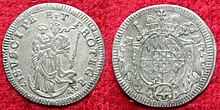Anselm Franz von Ingelheim (1683–1749)

Anselm Franz von Ingelheim (born November 12, 1683 ; † February 9, 1749 ) was Prince-Bishop of Würzburg from 1746 to 1749 . Some university reforms go back to him. So he shortened the study time of philosophy from three to two years.
Life
The Ingelheim family has its seat in Ober-Ingelheim near Mainz . Anselm Franz was the eldest child of Franz Adolf Dietrich Pfalzgraf, Imperial Baron and Imperial Count von Ingelheim called. Echter von and zu Mespelbrunn and Ursula Chamberlain von Worms, Baroness von Dalberg (1668–1730). He had 21 siblings and was the godchild of the Mainz Elector and Archbishop Anselm Franz von Ingelheim (1634–1695) , who was a great cousin of his grandfather.
His career began with the canons of Mainz and Würzburg. At the age of 21, he went to Rome with his brother Rudolf Johann Friedrich, who was two years his junior, in 1703 to the “studium biennale” in order to prepare for theology studies. On March 5, 1706, his brother died on his return journey in Venice and was buried there in the church of St. Cassiano. On December 31, 1728, Anselm Franz von Ingelheim was ordained a priest. He was the capitular at St. Alban's Abbey near Mainz and provost at St. Viktor's Abbey near Mainz . On August 29, 1746 he was elected Prince-Bishop of Würzburg by the cathedral chapter, which was followed by the imperial decree for nomination as Duke of Franconia . The confirmation by Pope Benedict XIV took place on November 28th, 1746. It was consecrated only on August 27th, 1747 " because of a congested and long-lasting illness ". The consecration was carried out by the Würzburg auxiliary bishop Johann Bernhard Mayer.
In contrast to his predecessor Friedrich Carl von Schönborn and his older brother and predecessor in Würzburg, Johann Philipp Franz von Schönborn , Anselm Franz von Ingelheim supported the builder Balthasar Neumann very little. Neumann was dismissed as chief construction director, but he continued to be employed as an officer. Ingelheim was considered greedy and addicted to profit and is said to have only been interested in goldmaking and alchemy , so that the construction of the residence stalled. A contemporary historian thinks: “He entertained at great expense various laboratory assistants who were brought in from foreign places and who were called upon to occupy them, but which on the one hand caused him a lot of misery, on the other hand a large part of his praise and glory Government which he would otherwise have had when he loved and respected fewer people like that "
Anselm Franz died after less than a year and a half in reign as Prince-Bishop of Würzburg. In the “devotional book” there is the following entry: d February 9th, 1749 IhroHochfürstl. Gn. found dead in the bed .
The Trier choir bishop Anton Dietrich Carl von Ingelheim (1690–1750) was his younger brother.

After the death of Anselm Franz, his successor Karl Philipp von Greiffenclau-Vollraths , a relative of the Schönborn family, reappointed Neumann as chief construction director.
See also
Web links
- Entry on Anselm Franz von Ingelheim on catholic-hierarchy.org
- List of bishops on the homepage of the Diocese of Würzburg
- Corrected list of the bishops of Würzburg after Heinrich Wagner
Individual evidence
- ↑ Klaus Wittstadt: Würzburger Bischöfe 742-1979, 1979 Echter Verlag, Franconian Society Printing Office Würzburg ( ISBN 3 429 00628 7 )
- ↑ Stotzinger o. Frh. From: Memorial sheets of the Echter von Mespelbrunn and the Counts of Ingelheim called Echter von Mespelbrunn . Archive of the Historical Association of Lower Franconia and Aschaffenburg Bd.L (1908)
- ↑ Devotional book in the Gräflich Ingelheim family archive, Mespelbrunn Castle
| predecessor | Office | successor |
|---|---|---|
| Friedrich Karl von Schönborn-Buchheim |
Prince-Bishop of Würzburg 1746–1749 |
Karl Philipp von Greiffenclau on Vollrads |
| personal data | |
|---|---|
| SURNAME | Ingelheim, Anselm Franz von |
| BRIEF DESCRIPTION | Würzburg Prince-Bishop (1746–1749) |
| DATE OF BIRTH | November 12, 1683 |
| DATE OF DEATH | February 9, 1749 |

